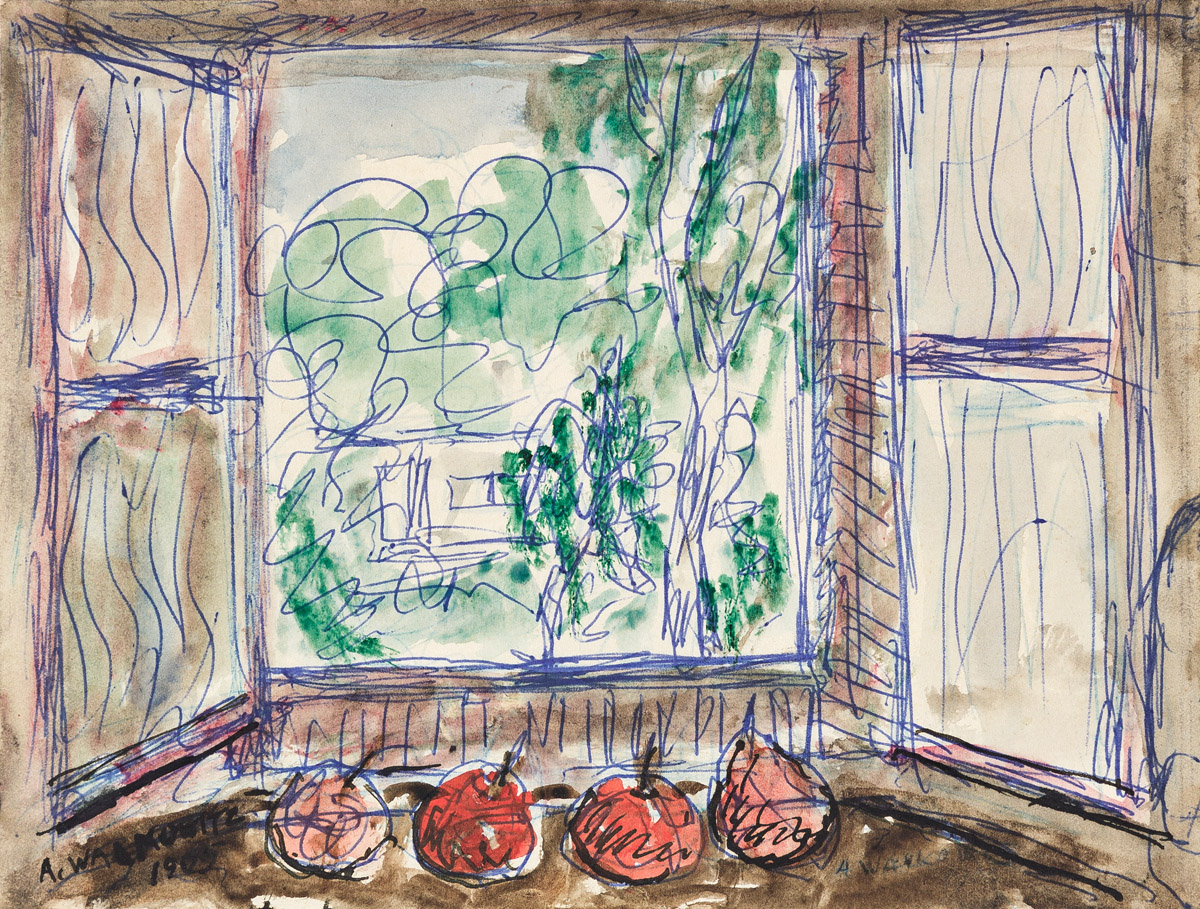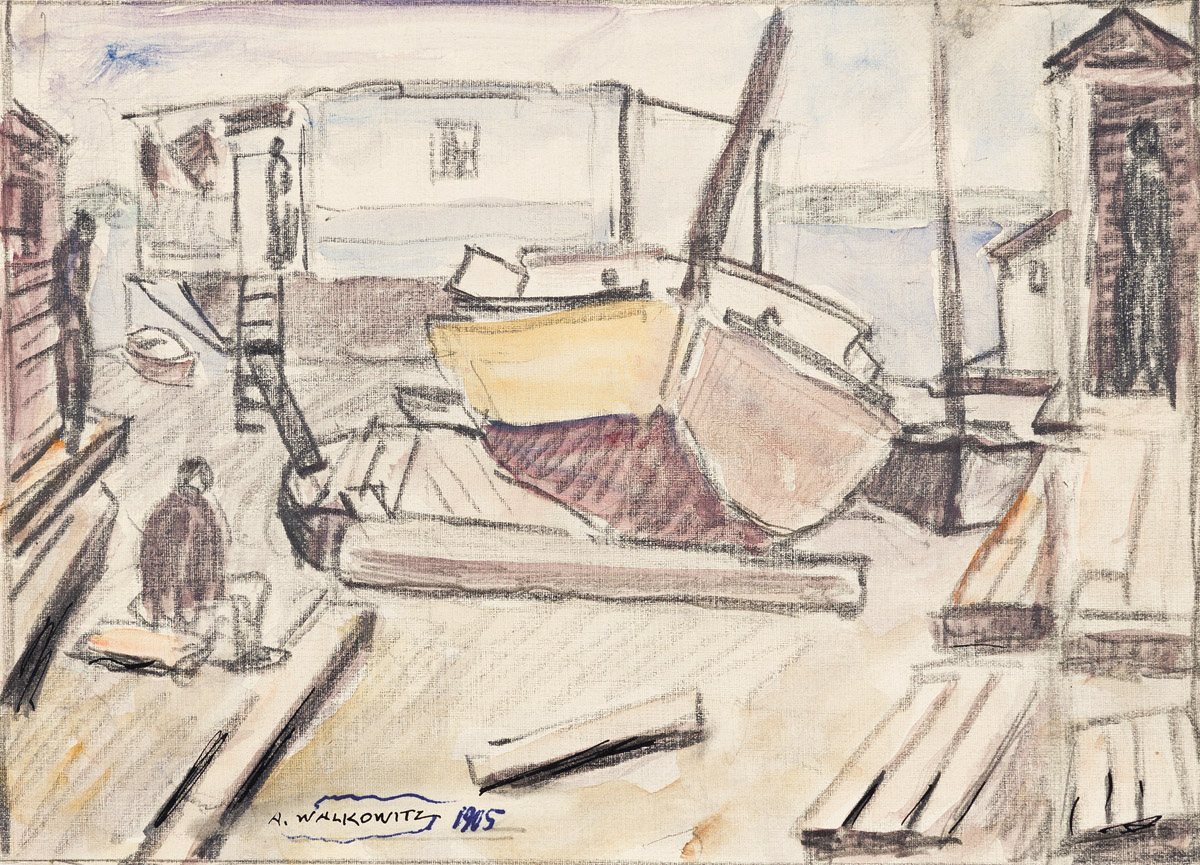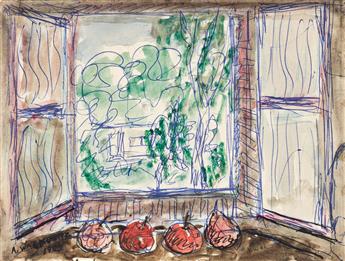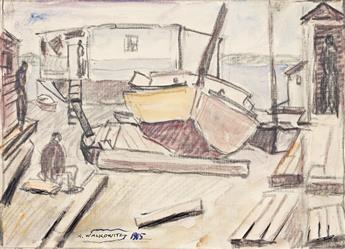Sale 2614 - Lot 65
Unsold
Estimate: $ 1,500 - $ 2,500
ABRAHAM WALKOWITZ
Two watercolors with ink.
Boat, 1905. 130x185 mm; 5 1/8x7 1/4 inches. Signed and dated in ink, lower center recto * Open Window with Fruit, 1909. 126x170 mm; 5x6 5/8 inches. Signed and dated in ink, lower left recto.
Provenance: Private collection, Tel Aviv, Israel.
Walkowitz (1878-1965) was born in Tyumen, Siberia to Jewish parents and immigrated to the Lower East Side of New York with his mother in 1889. He was trained in the academic style at the National Academy of Design, New York, and also at the Académie Julian in Paris, though his style was most influenced by his experiences outside of the studio. In Paris, Walkowitz was impressed by the landmark 1907 Paul Cézanne (1839-1906) retrospective exhibit at the Salon d'Automne and by his introduction to the work of Henri Matisse (1869-1954) and Henri Rousseau (1844-1910). By the time Walkowitz returned to New York, his style was heavily influenced by European Modernism, with emphasis on gestures, simplified forms and flat planes of bold color. His first solo exhibition was held at Haas Gallery, the back of a modest frame shop, in New York in 1908.
In 1912, Walkowitz met Albert Stieglitz (1864-1946) through Marsden Hartley (1877-1943) and became involved with 291, Stieglitz's New York gallery, which served as a hub of American modernism. Stieglitz was so impressed by the young artist, that he sent him to study art in Greece, Italy and North Africa in 1914. His style became more abstract; its reduced linear forms lent themselves to the city's rush skyward, prematurely anticipating the New York School and the Abstract Expressionists.
In 1913, Walkowitz was represented at the Armory Show and in the 1916 Forum exhibition. Walkowitz was concerned with politics and artists' rights and was active in various artist's groups, founding the People's Art Guild and the Society of Independent Artists (he became director of the latter from 1918 to 1938). In 1920, he exhibited at the Société Anonyme alongside Hartley and Joseph Stella (1877-1946). Despite local and international recognition, Walkowitz was not nearly as well-known as his contemporaries. Walkowitz painted into the 1940s, when his eyesight began to fail.
Two watercolors with ink.
Boat, 1905. 130x185 mm; 5 1/8x7 1/4 inches. Signed and dated in ink, lower center recto * Open Window with Fruit, 1909. 126x170 mm; 5x6 5/8 inches. Signed and dated in ink, lower left recto.
Provenance: Private collection, Tel Aviv, Israel.
Walkowitz (1878-1965) was born in Tyumen, Siberia to Jewish parents and immigrated to the Lower East Side of New York with his mother in 1889. He was trained in the academic style at the National Academy of Design, New York, and also at the Académie Julian in Paris, though his style was most influenced by his experiences outside of the studio. In Paris, Walkowitz was impressed by the landmark 1907 Paul Cézanne (1839-1906) retrospective exhibit at the Salon d'Automne and by his introduction to the work of Henri Matisse (1869-1954) and Henri Rousseau (1844-1910). By the time Walkowitz returned to New York, his style was heavily influenced by European Modernism, with emphasis on gestures, simplified forms and flat planes of bold color. His first solo exhibition was held at Haas Gallery, the back of a modest frame shop, in New York in 1908.
In 1912, Walkowitz met Albert Stieglitz (1864-1946) through Marsden Hartley (1877-1943) and became involved with 291, Stieglitz's New York gallery, which served as a hub of American modernism. Stieglitz was so impressed by the young artist, that he sent him to study art in Greece, Italy and North Africa in 1914. His style became more abstract; its reduced linear forms lent themselves to the city's rush skyward, prematurely anticipating the New York School and the Abstract Expressionists.
In 1913, Walkowitz was represented at the Armory Show and in the 1916 Forum exhibition. Walkowitz was concerned with politics and artists' rights and was active in various artist's groups, founding the People's Art Guild and the Society of Independent Artists (he became director of the latter from 1918 to 1938). In 1920, he exhibited at the Société Anonyme alongside Hartley and Joseph Stella (1877-1946). Despite local and international recognition, Walkowitz was not nearly as well-known as his contemporaries. Walkowitz painted into the 1940s, when his eyesight began to fail.
Exhibition Hours
Exhibition Hours
Aliquam vulputate ornare congue. Vestibulum maximus, libero in placerat faucibus, risus nisl molestie massa, ut maximus metus lectus vel lorem.






